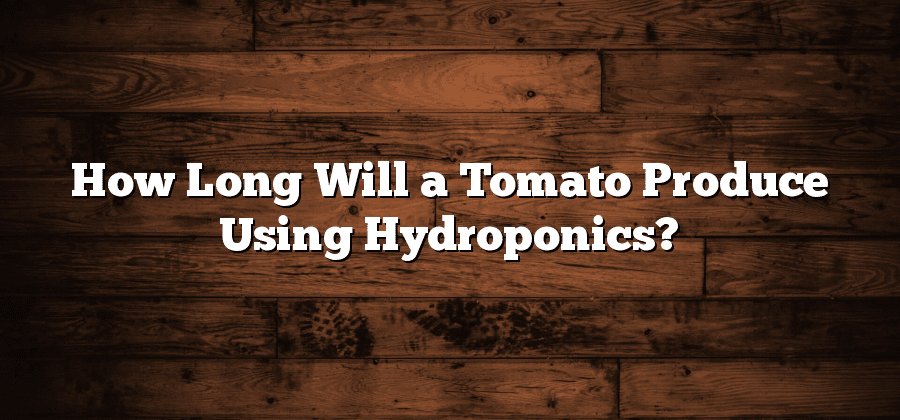Benefits of Growing Tomatoes Hydroponically
Hydroponic tomato cultivation offers numerous benefits for growers, making it an increasingly popular method of growing tomatoes. One major advantage is the ability to grow tomatoes year-round, regardless of the outdoor climate or season. This is especially beneficial for regions with long winters or erratic weather patterns, as it ensures a consistent supply of fresh tomatoes throughout the year. Additionally, hydroponic systems eliminate the need for soil, reducing the risk of soil-borne diseases and pests, which can be a common issue in traditional soil-based cultivation.
Another advantage of growing tomatoes hydroponically is the precise control over nutrient levels and pH. In hydroponic systems, growers have the ability to customize the nutrient solution to meet the specific needs of the tomato plants at each stage of growth. This ensures optimal nutrient uptake and promotes healthy plant development, leading to higher yields and better-quality tomatoes. Moreover, the pH of the nutrient solution can be carefully adjusted, enhancing nutrient availability and optimizing plant growth. This level of control allows for maximum efficiency and reduces the risk of nutrient deficiencies or imbalances that can hinder tomato production.
Understanding the Growth Cycle of Hydroponic Tomatoes
Hydroponic tomato cultivation offers a unique and efficient way to grow tomatoes without relying on soil. Understanding the growth cycle of hydroponic tomatoes is essential for successful cultivation and a bountiful harvest.
The growth cycle of hydroponic tomatoes can be divided into several distinct stages. The first stage is the seedling phase, where tomato seeds are germinated in a nursery and then transplanted into the hydroponic system. During this phase, the seedlings require proper humidity, temperature, and light conditions to establish roots and develop into healthy plants. Once the seedlings have established, they enter the vegetative phase, characterized by rapid growth and leaf expansion. This stage is crucial for developing a strong root system and healthy foliage, as it sets the foundation for future fruit production. Proper pruning and training are important during the vegetative stage to maintain the desired shape and promote optimal growth.
Factors Affecting the Lifespan of Hydroponic Tomato Plants
Factors affecting the lifespan of hydroponic tomato plants can vary greatly and understanding these factors is crucial for successful cultivation. One of the primary factors is the quality of the nutrient solution. Tomatoes require a balanced and properly formulated nutrient solution that provides the necessary macro and micronutrients, as well as the right pH level. Imbalances in the nutrient solution can lead to nutrient deficiencies or toxicities, adversely affecting the overall health and lifespan of the plants. It is essential to regularly monitor and adjust the nutrient solution to ensure optimal conditions for tomato growth.
Another factor that plays a significant role in the lifespan of hydroponic tomato plants is environmental conditions. Temperature, humidity, and lighting are all crucial factors that need to be carefully managed. Tomatoes thrive in warm temperatures around 70-80°F (21-27°C) during the day and slightly cooler temperatures at night. Maintaining proper humidity levels between 50-70% can also aid in preventing issues like fungal diseases. Additionally, providing adequate and appropriate lighting, such as high-intensity grow lights, is crucial for photosynthesis and the overall growth and development of tomato plants. Failure to provide optimal environmental conditions can lead to stunted growth, reduced fruit production, and even plant death.
Tips for Prolonging Tomato Production in Hydroponic Systems
To ensure a bountiful and extended tomato production in hydroponic systems, there are several key tips to keep in mind. First and foremost, providing the proper lighting is essential. Tomatoes thrive under intense light, so using high-quality grow lights with the appropriate spectrum is crucial. Additionally, it is important to maintain the right temperature and humidity levels within the growing environment. Tomatoes prefer a temperature range between 70-85°F (21-29°C) and a humidity level around 60-80%. Monitoring these conditions closely and making adjustments as necessary will help promote healthy growth and maximize production.
Another tip for prolonging tomato production is to pay attention to nutrient levels and pH balance in the hydroponic solution. Tomatoes have specific nutritional requirements, so maintaining the right balance of essential nutrients is critical for their overall health and productivity. Regularly testing the nutrient solution and adjusting accordingly will ensure that the plants have what they need to thrive. Additionally, keeping the pH level within the optimal range of 5.5-6.5 helps the plants absorb nutrients more efficiently. Regularly monitoring and adjusting the pH level will prevent nutrient deficiencies or toxicities that can hinder tomato production.
Common Issues and Troubleshooting in Hydroponic Tomato Cultivation
Among the common issues faced in hydroponic tomato cultivation, nutrient deficiency stands out as a major concern. When the plants do not receive adequate nutrients, they exhibit slow growth, yellowing of leaves, stunted fruit development, and overall poor plant health. This can be addressed by regularly monitoring and adjusting the nutrient solution according to the needs of the plants. Conducting regular water and nutrient testing can help in identifying deficiencies and maintaining optimal nutrient levels for the tomatoes.
Another issue that hydroponic tomato growers may encounter is the occurrence of pests and diseases. Aphids, spider mites, whiteflies, and fungal infections can pose a threat to the health and productivity of the plants. Implementing strict hygiene practices such as disinfecting growing equipment, maintaining a clean growing environment, and regularly inspecting plants for early signs of infestation can help in preventing and managing pest and disease outbreaks. Additionally, introducing beneficial insects or using organic pest control methods can provide an effective and environmentally friendly solution to combat these issues.






